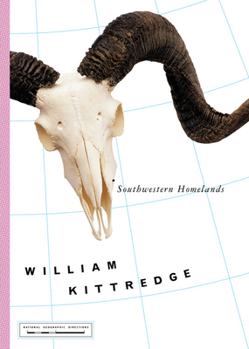Southwestern Homelands
Select Format
Select Condition 
Book Overview
For part of each of the last twenty years, much-loved essayist and fiction writer William Kittredge has ventured to the storied desert landscape of the American Southwest and immersed himself in the... This description may be from another edition of this product.
Format:Hardcover
Language:English
ISBN:0792265343
ISBN13:9780792265344
Release Date:June 2002
Publisher:National Geographic Society
Length:192 Pages
Weight:0.84 lbs.
Dimensions:0.5" x 4.1" x 6.0"
Customer Reviews
1 rating
Homelands are emotional homes
Published by Thriftbooks.com User , 20 years ago
In the upper Rockies movement south is pervasive. There is a yearning for nomadism. In the Southwest landforms are impossible to ignore. Human settlement runs up against aridity in the Southwest. The author first visited the Southwest in 1968 after attending writers' school at the University of Iowa. By 1976 Kittredge was saying that the American West was a manufactured story and it was in need of retelling. Kittredge writes that Edward Abbey wrote that the desert says nothing. Doug Peacock showed him that the Sonoran Desert ecology was as complex as that of a rain forest. It is an Arizona custom to seek wild flowers in the spring. The most secure homeland is the coherent self. Homelands are emotional homes. Homelands may be vast or small, overlapping, defined in many ways. Native cultures are stoic, mystical, ironic, and practical. High cultures in the Southwest were on the frontier. The pueblos were built to support a ceremonial system. The growth of native cultures in the Southwest was interrupted by Spanish warriors and Catholic priests. The Spanish never converted the Navajo to Catholicism or exerted much political control. Richard Wetherill and his brothers found the concentration of cliff dwellings in 1888, now the center piece of Mesa Verde National Park. Eventually they found 182 sites on Mesa Verde. They were the first to discover evidence of the Basketmakers who lived in the Southwest two thousand years before the Anasazi. Elaborate communal rituals sanctify vital relationships between communities and the natural world. The author was told by Gloria Emerson, a Navajo, to think of the mountains as books, instructing people. The Hopi believe in repetition and order, (not in contemporary man's belief in the need to reinvent one's self). The Hopi live in a one-to-one trade-off relationship with sacredness. The Hopi encourage rain to fall for the corn. Without rain, there is no corn. When the Hopi die they become benevolent beings known as Kachinas, becoming Cloud People. The Hopis are one of the few precontact cultures surviving in the United States. Everything in Hopi belief is dependent on rainfall. Hopi pueblos and Zuni pueblos are notable for their isolation. Ruth Benedict viewed Zuni culture as Apollonian. A couple of hundred years ago the culture of Spanish New Mexico solidified into a caste system. Intellectuals and artists tried to carve out utopian communities at Carmel, Provincetown, Woodstock. Homelands are cemented by networks of story. The colony of the 1920's in Taos/Santa Fe was inspired and orchestrated by Mabel Dodge Luhan. In 1918 she built an adobe mansion near Taos Pueblo. She put up famous people including Edward Weston, Paul Strand, Ansel Adams, Aldous Huxley, Georgia O'Keefe, and D.H. Lawrence. Lawrence, who was initially entranced, moved on, but his widow, Frieda, lived out her life in New Mexico. Georgia O'Keefe came to New Miexico in 1929. In 1940 she bought an adobe house at Gh





